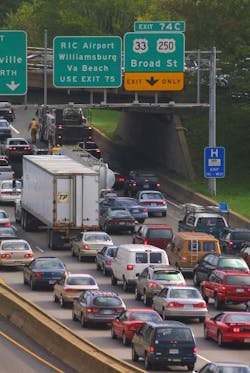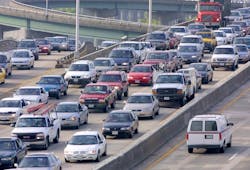First, a little near-term data regarding the increasing zoom of highway travel across our nation. AAA, for one, is estimating that 34.1 million Americans will journey 50 miles or more from home during the upcoming Labor Day holiday – a 4.2% increase from the 32.7 million people who traveled during the same Aug. 30 thru Sept. 2 holiday period last year – and that 85% them (some 29.2 million folks) will travel by automobile, an increase of 4.3% from 28 million in 2012.
“We’re forecasting a lift in Labor Day travel this year due to the increasingly positive economic outlook and optimism in the housing market," noted Robert Darbelnet, AAA’s president and CEO. "For many Americans, their home is also their biggest asset, and as home prices improve in many parts of the country more families are feeling comfortable about traveling this Labor Day holiday."
Low gasoline prices are also a contributing factor to the expected boost in holiday travel, with AAA noting that as of mid-August, gasoline pump prices were on average down 2.7% per gallon compared to the same time year. By comparison, the average price for gas on Labor Day 2012 was $3.83 per gallon, said AAA – the most expensive average ever on record for the holiday – while the current national average price for a gallon of regular gas is $3.54, some 18 cents lower than last year.Highway travel is also on the upswing as well, according to new data released by the Federal Highway Administration (FHWA). That agency’s research found that vehicles traveled 2.95 trillion miles on U.S. roads in 2011 – the eighth-highest level ever recorded, and nearly double the amount traveled in 1980.
FHWA added that based on traffic volume data from 2011 – the most recent year available – California’s I-5 highway is the nation's busiest interstate, with 21.4 billion miles traveled that year. The neighboring I-10 and I-110 interstates in the Golden State followed as the second and third busiest, respectively, with the Los Angeles' section of I-405 – carrying an estimated 379,000 vehicles per day – ranked as the busiest interstate in any American city.
In terms of state highway volume, FHWA said California is ranked number one with 84.7 billion miles of highway travel, followed by Texas at 55.7 billion miles, Florida at 34.7 billion miles, and Ohio at 31.4 billion miles.
Yet that amount of “ground pounding” is going to put more wear and tear on our already well-worn roadways, necessitating as always a renewed discussion of how to fund highway expansion, upkeep, and repair.
This discussion is certainly not academic to the freight world, as highways provide the main arteries for shipping some $19 trillion (with a ‘T’!) worth of goods throughout the U.S. in 2011, as the video clip below, courtesy of the American Association of State Highway and Transportation Officials(AASHTO), details:
Yet as I related in a post earlier this week, C. Kenneth Orski – a noted public policy consultant and 30-year veteran transportation expert – reported in his coverage of the latest Congressional hearing on the state of the Highway Trust Fund (HTF) in late July that a six-year transportation bill would require roughly $320 billion or $53 billion annually to maintain current spending levels – yet HTF revenue and interest over the same period are only expected to bring in some $240 billion, according to the Congressional Budget Office (CBO), thus leaving an unfunded shortfall of $80 billion.
“Even a stop-gap one-year bill would require an extra $15 billion and increasing amounts in subsequent years to prevent future shortfalls if spending was maintained at the 2013 levels,” Orski said.Orski believes that rather than wrangle over federal funding mechanisms, individual states should be given broader freedom bring their transportation facilities up to a state of good repair with locally raised revenue, supplemented with their regular federal-aid highway funds.
As for large-scale reconstruction and system expansion projects that are beyond the states' fiscal capacity to fund on a "pay-as-you-go" basis, let them be financed with long-term credit and private investment capital, Orski explained.
“While this might limit new investment to credit-worthy projects, such as those that generate revenue or are backed by dedicated taxes, a vast majority of transportation megaprojects already fall in that category,” he said.
In fact, Orski thinks this is precisely what's happening now all across the U.S., albeit in a quiet under-the-radar manner.
“A growing number of states aren't waiting for the financially troubled federal government to come to the rescue with new money [and] are taking matters into their own hands and taking control of their infrastructure agendas,” he pointed out.
“Our recent survey identified as many as 20 such "Can-Do" states [and], in addition, eight states are financing big-ticket highway and bridge projects with long-term credit and private financing without direct federal funding,” Orski said. “Indeed, except for mass transit projects there are no major transportation facilities under construction or on the drawing board today whose completion hinges on federal appropriations.”
But this isn’t to say it’s an easy process. For example, take recent comments made by Colorado Department of Transportation (CDOT) Executive Director Don Hunt: he explained that his agency is trying to do more with less funding by dismantling and then systematically rebuilding existing operating practices to improve customer service and overall efficiency.
"Our primary focus has been use practices and procedures that can help CDOT become a more dynamic organization," said Hunt. "Also, a private effort led by our Governor [John Hickenlooper] pulled together 1,000 Coloradoans to talk about our investment problems for the future has started a state-wide conversation about finding an additional source of funding for transportation."
[You can view more of Hunt’s comments in the video interview below.]
Orski stressed, though, that greater state government involvement in funding transportation is a phenomenon of far-reaching consequences.
In the short run, more state revenue dedicated to transportation will lessen the pressure on Congress to come up with increased resources to fund the next reauthorization. Indeed, this may already be happening, he believes, as illustrated by the fact that no governor or state legislator – nor their association representatives – joined Sen. Barbara Boxer (D-CA) on the podium during her recent call-to-arms to save the HTF from insolvency.
“Her sense of urgency about increasing federal investment in transportation infrastructure does not seem to be shared in state capitals which increasingly are showing impressive signs of fiscal independence and financing innovation,” Orski said.
In the longer run, greater state fiscal autonomy could modify the federal-state relationship in transportation, he thinks.
“There would be less need for direct financial aid to state DOTs and more emphasis on credit assistance to support transportation investments of truly national scope and significance … though the need for federal oversight of transportation design, construction and safety standards would, of course, continue,” Orski noted.
This, to his mind, is not “devolution” in terms of how to fund U.S. transportation needs. “This is the new reality of states acting responsibly to preserve their transportation assets and modernize their infrastructure in the absence of adequate federal assistance,” Orski stressed. “And in the process of doing so, states will be helping to relieve the Congress of the politically embarrassing task of repeatedly having to dip into the general revenue fund to bail out the ailing HTF.”
We’ll see, then, if this state-led transportation funding effort gets legs for the long haul.






